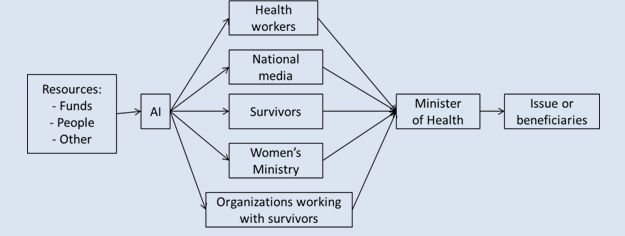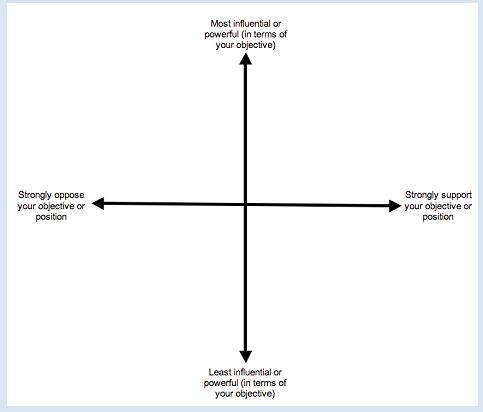The tools presented here are most commonly applied in campaigns for policy/institutional change. They can also be used to visualize the various social groups that are likely to have an influence on the target audiences of behaviour change campaigns. See also Stakeholder Analysis in the Campaign Planning section.
Influence maps
These maps show who has influence over a specific issue, placed at the center of the map.
The example below visualizes access to appropriate medical treatment for domestic violence survivors. Second- and third-level actors or stakeholders who influence those shown on this simple map could be added to the left and to the right of the map. For example, “survivors of violence” are likely to be influenced by family members, peers, religious leaders and other actors. In a more complex influence map, these actors would be shown to the left of “survivors of violence” in the map.

Source: Making Rights a Reality: Building Your Campaign, Amnesty International, 2004.
Channels of influence
These describe how different actors can contribute to channeling the message to your primary target audience. In the example below, “AI” stands for Amnesty International in its campaign on health services for VAW survivors (AI, 2004).

Source: Making Rights a Reality: Building Your Campaign, Amnesty International, 2004.
Power mapping
This mapping focuses on determining the influence of different stakeholders in relation to the campaign issue. The tool below can be drawn on a large sheet of paper. Small cards or self-adhesive paper can be used to map the different actors on a two-dimensional space.

Source: The Change Agency, Power Mapping, 2010 - offers detailed guidance on power mapping.
Force field analysis describes which forces contribute to maintaining an undesirable situation, which forces may cause the situation to change, and how strong each force is. This tool helps to identify and prioritize potential allies and targets.
Force field analysis
Using the following table (adapted from The Change Agency), begin by listing the forces (organizations, powerful individuals) that may contribute to reaching your campaign goal to the left, and those that pose obstacles to the right. In a second step, you rate the strength of each force relative to the campaign issue (e.g. +10 to +1 and —10 to —1).
|
Forces for Success (+) |
Forces against Success (-) |
|
|
|
|
|
|